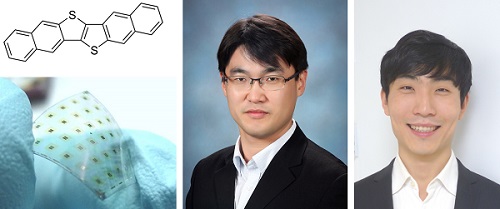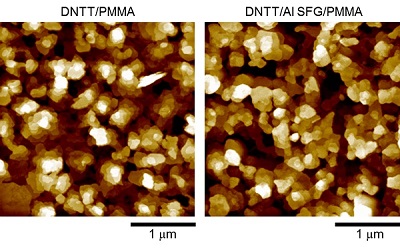Media Center
A multimedia mosaic of moments at GIST
GIST Excellence
[Press release] Professor Myung-Han Yoon leads research team to develop a new synaptic organic transistor for neuromorphic devices
- 엘리스 리
- REG_DATE : 2016.09.23
- HIT : 905
Professor Myung-Han Yoon leads research team to develop
a new synaptic organic transistor for neuromorphic devices

(From left): Chemical structure of DNTT and a photograph of flexible OFET arrays,
Professor Myung-Han Yoon, and Dr. Chang-Hyun Kim
Neuromorphic computing describes an artificial system that mimics biological neural systems. Developing such a system that has parity with the human brain would revolutionize computers because the human brain uses vastly less power than traditional von Neumann architecture-based computers and would not be hampered by their limited data transfer rates between the central processing unit and the memory storage device. The creation of such a system would require electronic synapses, but current synaptic transistors (synapstor) are unable to achieve both good charge transport and good memory performance, requiring a trade-off between one and the other.
To overcome this problem, Professor Myung-Han Yoon of the School of Materials Science and Engineering at the Gwangju Institute of Science and Engineering has led a research team to develop a synapstor structure with a high channel conductance and an efficient memory characteristic by using a metallic nanosheet and organic materials. They accomplished this by using a vacuum-processed, nanoscale metallic interlayer to create an ultra-flat surface for a high-mobility molecular film as well as a desirable degree of charge trapping that allowed for low-temperature fabrication of uniform device arrays on plastic. The manufacturing costs are also kept low because the device architecture is implemented by widely available electronic materials in combination with conventional deposition methods.

AFM topography: 3.0 μm × 3.0 μm for the ‘DNTT/PMMA’ and ‘DNTT/Al SFG/PMMA’ images
Their paper entitled "Synaptic organic transistors with a vacuum-deposited charge-trapping nanosheet" was authored by Chang-Hyun Kim, Sujin Sung, and Myung-Han Yoon and was published on September 20, 2016, by Scientific Reports.

Illustration of the neuronal signal transmission through a synaptic connection, neuromorphic device scheme using our DNTT SFG-OFET, time-domain input synaptic voltage (Vsyn) pulses, and the measured synaptic currents (Isyn) from representative devices.
Professor Myung-Han Yoon said, "Organic semiconductor-based transistors are similar to neurological structures of living organisms, and our research represents a promising building block for flexible neuron-inspired circuits and multifunctional interfaces."